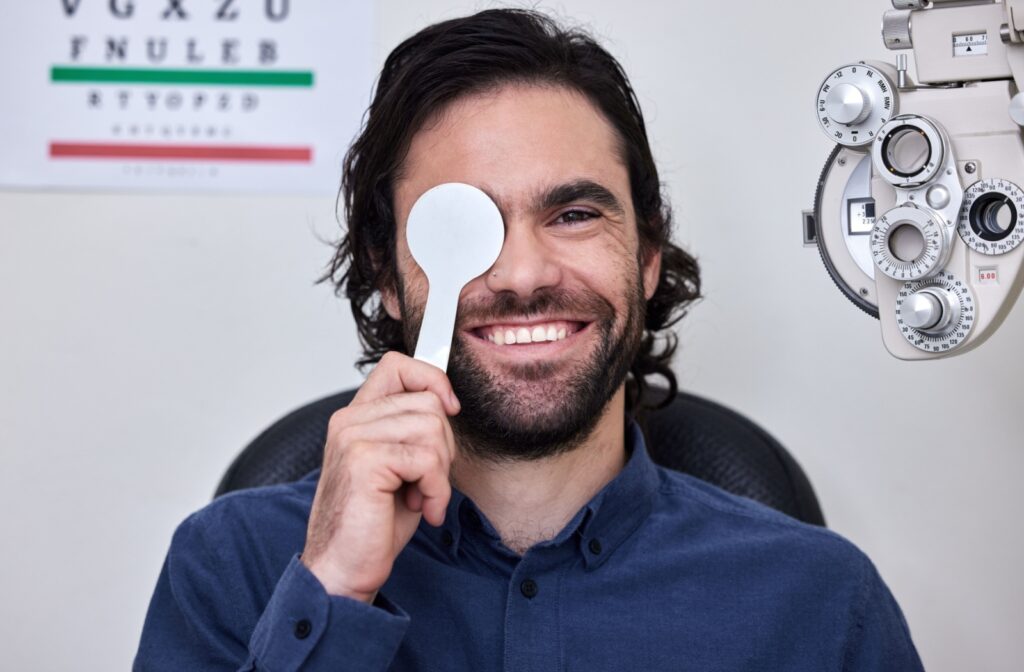Eye tracking problems can affect reading, driving, and even basic focus, but they’re often overlooked in adults.
Eye movement relies on precise coordination between your brain and your visual system. When this balance is disrupted, it can lead to fatigue, discomfort, or challenges with everyday tasks. From neurological conditions to visual processing disorders, several factors can interfere with the smooth movement and coordination of your eyes.
What is Eye Tracking?
Eye tracking refers to the ability of the eyes to move smoothly and accurately to fixate, follow, and shift focus between objects. This coordination is important for activities such as reading, where the eyes must move line by line, and for following objects in motion, such as during sports or driving.
When these movements are disrupted due to underlying issues, you may experience challenges in visual tasks, eye strain, or even headaches.
Cases of Eye Tracking Problems in Adults
Several factors may contribute to eye tracking challenges. Identifying the root cause is important to determining an effective treatment plan.
Neurological Conditions
Neurological diseases are a cause of eye tracking problems in adults. Conditions such as stroke, multiple sclerosis (MS), and traumatic brain injuries can affect the regions of the brain that control eye movement.
- Stroke survivors, for example, may experience muscle weakness or damage to the neural pathways responsible for eye movement, resulting in double vision or difficulty tracking objects.
- Traumatic brain injuries, including concussions, can disrupt visual skills, leading to symptoms like blurred vision, dizziness, and poor eye coordination.
Vision Disorders
Certain vision disorders can disrupt proper eye tracking, including conditions like strabismus and convergence insufficiency.
- Strabismus (eye misalignment) makes it difficult for both eyes to focus on the same object, leading to challenges with maintaining gaze stability.
- Convergence insufficiency is another common issue, where the eyes struggle to work together when focusing on nearby objects, resulting in eye strain during tasks like reading.
Aging
Age-related vision changes can also contribute to eye tracking issues.
- Presbyopia, a condition where the eyes lose their ability to focus on close objects, is common among aging adults and can indirectly affect eye movement.
- Other conditions, such as cataracts or macular degeneration, can reduce visual clarity, compromising the coordination of eye movements.
Medicated Side Effects
Certain medications are known to interfere with eye tracking. Common culprits include antidepressants, antihistamines, and medications for seizure disorders. These can cause side effects such as blurred vision or dizziness, which can make eye movements less fluid.
Fatigue & Stress
Physical and mental fatigue can strain the eye muscles and reduce coordination. Prolonged stress or exhaustion, particularly caused by excessive screen time, can lead to symptoms of digital eye strain, including blurred vision, headaches, and dry eye.
Visual Processing Disorder
Conditions like dyslexia and other visual processing disorders disrupt the brain’s ability to interpret visual information effectively. Those with these conditions may struggle with eye tracking, particularly during tasks like reading.
Diagnosing Eye Tracking Problems
Diagnosing eye tracking issues typically requires a comprehensive eye examination. This process includes evaluating visual acuity, eye alignment, and eye movement patterns.
Optometrists specializing in vision therapy often conduct additional assessments, including tests for depth perception, focus flexibility, and tracking skills. These evaluations provide valuable insights into how the eyes work together and aid in creating effective treatment plans.
Symptoms of Eye Tracking Problems
Recognizing the symptoms of eye tracking issues can help prompt early diagnosis and treatment. Some potential signs include:
- Difficulty reading, including skipping lines or losing your place
- Frequent squinting or closing one eye while focusing
- Blurred vision or double vision
- Trouble following moving objects, such as in sports
- Persistent eye strain or discomfort after visual tasks
If you notice any of these symptoms in yourself or someone you know, it’s important to seek professional help to address the underlying issue.

Treatment Options
Treatment for eye tracking issues varies based on the specific cause and severity of the condition. Common interventions include the following:
Vision Therapy
Vision therapy is a noninvasive and often effective treatment option for eye tracking problems. This program includes exercises designed to strengthen and train eye muscles, improve coordination, and visual processing abilities.
Prism Glasses
For individuals with alignment issues, such as strabismus, prism glasses can be a game-changer. These special lenses help realign vision, improving focus and reducing double vision.
Medication Adjustments
If eye tracking difficulties are linked to medication side effects, your healthcare provider may recommend a dosage adjustment or an alternative prescription.
Lifestyle Changes
Simple changes, such as managing screen time, practicing stress-relieving techniques, and taking frequent breaks during visually demanding tasks, can help alleviate eye strain.
Surgery
Although rare, in cases where severe muscular damage is the cause, surgical interventions may be necessary to restore proper eye movement.
Your Vision Deserves Attention
Eye tracking problems can significantly impact your daily life. Therefore, taking proactive steps to care for your vision can improve your eye health. At Fort Myers Eye Associates, we’re committed to providing care personalized to your needs. Our team of optometrists specializes in diagnosing and treating ocular health, offering services such as vision therapy and comprehensive eye exams.
If you’re experiencing symptoms or are overdue for an eye exam, don’t wait. Schedule an appointment with us today, and take the first step toward clearer, more comfortable vision.




